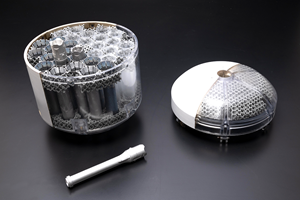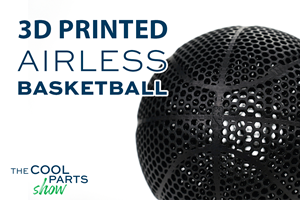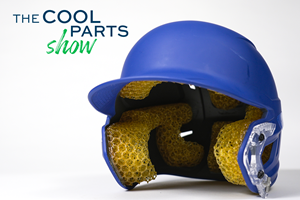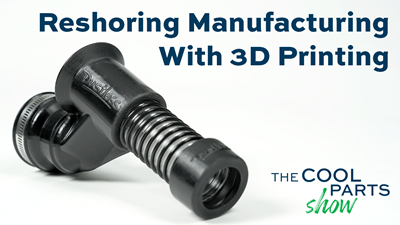Spencer Loveless, CEO of Merit3D, believes there has not been a promotional pen manufactured entirely in the United States since before the turn of the century. The economics haven’t allowed it. But additive manufacturing changes the equation. 3D printing combined with a design minimizing material use is allowing Merit3D to make promotional pens profitably within the U.S., within the price point accepted for these items. As a bonus, the buyer’s custom graphic is not just 2D printed on, but instead 3D printed into the form of the pen. Loveless is also CEO of Dustless Technologies, a company we met in the previous episode. This bonus episode explores the work with pens — an item few might have considered to be an opportunity for AM. | This episode of The Cool Parts Show brought to you by Carpenter Additive
The Cool Parts Show is a video series from Additive Manufacturing Media that explores the what, how and why of unusual 3D printed parts. Watch more here.
Have a cool part to share? Email us.
Related Resources
- Merit3D
- Dustless Technologies
- Subscribe to our magazine and newsletter so you might get a pen!
Transcript
Peter Zelinski
I'm Pete.
Stephanie Hendrixson
I'm Stephanie.
Peter Zelinski
Here's a quick special bonus episode of The Cool Parts Show.
Stephanie Hendrixson
At the end of this, we have a cool giveaway for you. So you're gonna want to watch all the way through. But Pete, we just did an episode on the DustBuddie from Dustless Technologies and you have an update on that.
Peter Zelinski
The DustBuddie, Dustless Technologies' first US made product, a reshoring story. Dustless Technologies based in Utah is transitioning much of its production to 3D printing, and it is helping other manufacturers make the same transition. It spun off a sister company Merit3D to help other manufacturers with their own additive manufacturing journey. Merit3D has been looking for 3D printing wins, including wins that involve inexpensive products.
Stephanie Hendrixson
Okay, so this is kind of a branded pen clearly 3D printed, but it kind of looks like something you might give away or pick up at a tradeshow, right.
Peter Zelinski
It is a giveaway promotional pen. Totally true. So Spencer Loveless CEO of Merit3D. In his research, he discovered it has quite possibly been decades, since any promotional pen whatsoever was made in the US. Thanks to 3d printing, here is a US made promotional pen.
Stephanie Hendrixson
Pete, I look at this, and I think about like the quantities of promotional pens that people produce. And I guess the question that comes to mind is we often hear that additive manufacturing is more expensive per part than something like injection molding. How do the economics work here?
Peter Zelinski
Yeah, the economics are kind of the story here. I'll let Spencer loveless speak to that.
Spencer Loveless
Yes. So we recently discovered how 3D printing can be an opportunity to be used in promotional items. As we were talking, we said, you know, a lot of these components that we're making, we're marketing to manufacturers. But what are some of the other needs out there that we have that usually are done from overseas? We're sitting there taking down notes, and we're like, ah, I have a pen in my hand, how can we make this? And so we put our engineers and our interns to work, and they came up with an idea for a 3D printed pen. And so this is the very first pen to be made in the US in the last 20 years that's used for promotional items. Most of them are imported, and then pad printed. But we're able to print customers logos, right there on the backside of the pen. This sells for $2. Which pens today sell from anywhere from 50 cents to $3. So we're very well in the price range. When when Merit3D makes a pen, we can fit 300 pens on a build. So today, our capacity is just about 5000 pens, and I say 5000 pens, that's actually just on an eight hour shift. So if we had two or three shifts, you know, 15 to 20,000 pens a day is what we could produce. With the with the other capabilities that we're bringing in house within the next few months, up to that doubling to 40,000 pens, 30 to 40,000 pens is very achievable. At that rate, it kind of gets economies of scale getting there too, so where now the pen may sell for $2, we could get it down to $1.50.
Stephanie Hendrixson
Alright, so what Spencer saying is making a lot of sense, like you can batch a lot of these pens into one 3D printer. Once you've got the part file in there, it can just run unattended, you don't have to stand there and watch it. And if you're doing multiple shifts a day, you can make lots and lots of these pretty quickly. I guess that's the end of my questions for now. But Pete, how can somebody get a beautiful and functional 3D printed pen?
Peter Zelinski
I am so glad you asked. So it's pretty straightforward. We're going to give away pens to our subscribers. We're going to give away 3D printed pens to some subscribers chosen at random. Go subscribe, go to AdditiveManufacturing.media, look toward the top of the page, subscribe to our magazine, subscribe to our newsletter, subscribe to either one. We are going to pull some names at random. We're going to look at new subscribers who were added soon after this episode dropped. So you might have a great chance of being in that pool. We're not going to shut out our existing subscribers either, we're going to go to that list too and pull some names at random. And then we're going to wait a little while and a little ways into the future we're going to do exactly the same thing. So if you happen to catch this episode later, you find it for the first time later, go subscribe, there's still a chance to win one of these 3D printed pens.
Stephanie Hendrixson
That's it for this special bonus episode of The Cool Parts Show. Again, go subscribe and we might send you your very own 3D printed pen made right here in the USA. Thanks for watching.
Peter Zelinski
Signing off, signing with like a pen.
Related Content
3D Printed Lattice for Mars Sample Return Crash Landing: The Cool Parts Show Bonus
NASA Jet Propulsion Laboratory employs laser powder bed fusion additive manufacturing plus chemical etching to create strong, lightweight lattice structures optimized to protect rock samples from Mars during their violent arrival on earth.
Read MoreAirless Basketball Shows Promise of 3D Printed Lattices: The Cool Parts Show Bonus
Successfully matching the performance of a standard basketball demonstrates the control possible over the mechanical properties of digital materials.
Read More3D Printed Lattices Replace Foam for Customized Helmet Padding: The Cool Parts Show #62
“Digital materials” resulting from engineered flexible polymer structures made through additive manufacturing are tunable to the application and can be tailored to the head of the wearer.
Read More3D Printed Spacer Grids for Nuclear Power: The Cool Parts Show #79
Westinghouse Electric Company is exploring laser powder bed fusion as a means of manufacturing spacer grids, critical parts of the fuel rod assemblies used in pressurized water reactors.
Read MoreRead Next
Angled Makes It Possible for Anyone to Launch a 3D Printed Product
The online store utilizes open capacity at its sister 3D printer farms for on-demand production with no startup costs, allowing designers to sell physical products as easily as digital ones.
Read MoreReshoring Manufacturing With 3D Printing: The Cool Parts Show #34
Wet-dry vacuum maker shifts to additive manufacturing for first entirely U.S.-made product, a jackhammer accessory. More U.S. production to come via 3D printing.
Read MoreAlquist 3D Looks Toward a Carbon-Sequestering Future with 3D Printed Infrastructure
The Colorado startup aims to reduce the carbon footprint of new buildings, homes and city infrastructure with robotic 3D printing and a specialized geopolymer material.
Read More



















